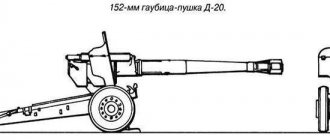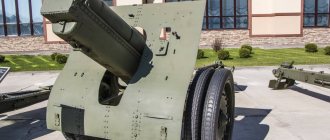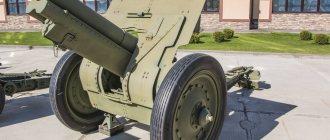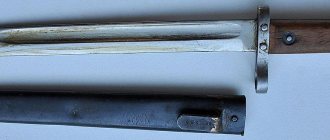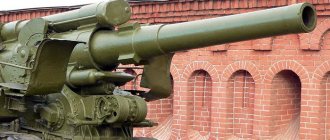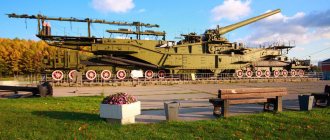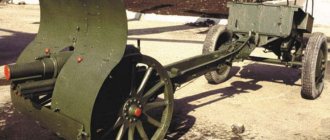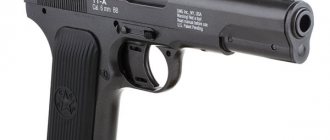Simple, reliable, killer
The 122-mm howitzer D-30 was adopted by the USSR in 1963.
It replaced the legend of World War II, the M-30 howitzer - an undoubtedly beautiful weapon, but morally outdated. For the first time, a Soviet howitzer was placed on a machine with circular rotation. This greatly increased the practical rate of fire - to radically change the horizontal aiming angle, it was no longer necessary to turn the carriage manually. On a good road, the D-30 can be transported at speeds of up to 80 kilometers per hour, and the howitzer can be prepared for battle in a minute and a half.
The crew of the D-30 howitzer of the Afghan army fires
The weapon turned out to be simple, reliable, accurate and lethal. These characteristics—and the fact that the Soviet government handed out howitzers and licenses to manufacture them—made the D-30 one of the most popular artillery systems in the world. There are about fifty countries operating this weapon.
In the Russian army, the D-30 remains in service only in the Airborne Forces, a little in the Ground Forces and the Russian Guard. And then - in the near future they must give way to self-propelled guns. They are also thinking about increasing the mobility of towed howitzers in other countries
With modern artillery reconnaissance equipment and clouds of drones, it is important for a battery not only to quickly shoot back, but also to escape even faster from a retaliatory strike. If you don’t have much money in your military budget, but want a self-propelled artillery unit (self-propelled artillery unit), you urgently need to put available howitzers on some kind of chassis
M-30 abroad[edit]
122 mm howitzer model 1938 (M-30) in the Beyt ha-Totchan museum, Israel. Right view
At the beginning of the Great Patriotic War, a significant number (several hundred) of M-30s were captured by the Wehrmacht. The gun was adopted by the Wehrmacht as a heavy howitzer 12.2 cm sFH396(r)
and was actively used in battles against the Red Army. Since 1943, the Germans even launched mass production of shells for this gun (as well as a number of earlier captured Soviet howitzers of the same caliber). In 1943, 424 thousand shots were fired, in 1944 and 1945. - 696.7 thousand and 133 thousand shots, respectively. Captured M-30s were used not only on the Eastern Front, but also in the defenses of the Atlantic Wall on the northwestern coast of France. Also, some sources mention the use by the Germans of M-30 howitzers to arm self-propelled guns, created on the basis of various captured French armored vehicles.
In the post-war years, the M-30 was exported to a number of countries in Asia and Africa, where it is still in service. It is known that such weapons exist in Syria and Egypt (accordingly, this weapon took an active part in the Arab-Israeli wars). In turn, part of the Egyptian M-30s was captured by the Israelis. One of these captured guns is on display at the Beyt-ha-Totchan Museum. The M-30 was also supplied to countries participating in the Warsaw Pact, for example, to Poland. At the Poznań Citadel Memorial, this weapon is included in the museum's weapons display. The People's Republic of China has launched its own production of the M-30 howitzer called Type 54
.
D-74 cannon 122 mm caliber. Firing range. Dimensions. Weight
At the end of the 40s, the Soviet Army needed a replacement for the 122 mm A-19 (M1931/37) cannon, which was developed in a hurry and produced in small quantities until 1945, but was recognized as too heavy, and also had too short a firing range for its intended purpose. than the role of fighting enemy artillery. As a result, the 130-mm M-46 field gun was adopted for service, but the development of the design bureau under the leadership of Petrov was also put into production in small quantities. Subsequently, it was this gun, which first appeared in the army in 1955, that received the designation 122-mm field gun D-74.
Although the D-74 gun was supplied in very limited quantities to parts of the Soviet Army (these guns are probably still in reserve), most of the guns produced were sent for export to countries such as China, Egypt, Cuba, North Korea and Vietnam. One batch of guns was even delivered to Peru, and the Chinese were so impressed by the D-74 that they launched their own production of analogues, designated the 122-mm Type 60 gun.
The barrel of the D-74 cannon is mounted on the same carriage as that of the D-20 howitzer gun - a conventional two-frame one with a pallet and a plate for hanging the wheels in the firing position. With the help of this plate, the entire gun can be quickly and easily rotated 360°. The long barrel, approximately 50 calibers long, is equipped with a double slot muzzle brake. The gun has a relatively small shield and additional wheels at the ends of the frames for ease of maintenance.
The types of ammunition used by the D-74 cannon are basically the same as those used by other 122 mm artillery systems with cap loading, but the power of the propellant charges can be different. The maximum firing range is 24,000 meters. As is customary with Soviet-developed artillery systems, the D-74 cannon can be used to combat armored targets. For this, an armor-piercing projectile weighing 25 kg with a solid core is used, capable of penetrating armor 185 mm thick at a distance of 1000 meters. However, at present, ammunition of this type for all artillery systems is considered obsolete and is practically not used.
Design
In those years, F. Petrov led the work of the experimental design bureau of plant No. 9. When creating the new Soviet howitzer D-30, weapons engineers took into account the weaknesses that were inherent in the M-30. The gun had insufficient accuracy and was not suitable for all-round firing. The peculiarity of the D-30 howitzer (a photo of the gun is presented in the article) was the unusual design of the carriage. Structurally, it was very different from the carriages of other artillery weapons used by the Soviet army. In an effort to make it possible for the new howitzer to carry out circular attacks, the carriage for it was equipped with three frames. The gun also differed in its towing method: the muzzle brake was attached to a pivot beam.
History of creation
The D-30 howitzer appeared as a replacement for the divisional 122 mm howitzer M-30 developed by the Motovilikha plant design bureau, under the leadership of Fedor Fedorovich Petrov in 1938. The practice of using the M-30 during the Great Patriotic War revealed both the positive aspects of the weapon and its disadvantages. The disadvantages of the M-30 included low accuracy of fire and the design of the carriage, which did not allow all-round firing.
Like the development of the M-30, the design of its replacement in the late 50s was entrusted to Fedor Petrov, who headed the Design Bureau of Plant No. 9. The initial development was called the D-30 (2A18). The main difference from the guns previously in service with the Soviet Army was the installation of the gun on a carriage of three frames, which were positioned at an angle of 120°, which increased the stability of the gun during all-round fire. Also new was the towing of the gun forward with the barrel. The tow bar of the tractor was hooked onto a pivot beam attached to the muzzle brake on a hinge. When bringing the gun into firing position, the body of the gun was raised with a jack with the support plate resting on the ground. The wheels on the rotary axles tilted upward.
The next modification of the D-30, which appeared in 1978, received the designation D-30A and was distinguished by the rigid design of the pivot beam, which was integral with the muzzle brake. In the muzzle brake, instead of 5 pairs of large slots and 1 small one, 2 chambers were used. Electrical equipment was installed on the armored shield for the convenience of transporting the gun in a column (turn indicators and side lights).
Basic technical data D-30A (2A18M)
Ballistic
starting speed
- Initial speed of a high-explosive fragmentation projectile (full charge): 690 m/s
- Initial speed of a high-explosive fragmentation projectile (reduced variable charge): 276—565 m/s
- Initial velocity of the cumulative projectile: 740 m/s
- Maximum pressure of powder gases: 250 MPa
- Longest firing range: 15.4 km
- Weight of high-explosive fragmentation projectile: 21.76 kg
- Weight of cumulative projectile: 14.08 kg
- Charge weight (full): 3.8 kg
Constructive
- Barrel length with muzzle brake (without pivot beam): 4.66 m (38klb)
- Barrel length without muzzle brake: 4.3 m (35klb)
- Threaded length: 3.4 m
- Number of grooves: 36
- Maximum elevation angle: 70°
- Lowest declination angle: −7°
- Horizontal firing at a barrel elevation angle from −5° to 18°: 360°
- Horizontal fire at an elevation angle from +18° to 70° and with the barrel positioned between the movable frames: 66°
- Horizontal fire at an elevation angle from +18° to 70° and with the barrel positioned between fixed and movable frames: ±29°
- Amount of Steol M liquid in the sliding brake: 10.3 l
- Amount of Steol M liquid in the knurl: 9.7 l
- Amount of Steol M liquid in the balancing mechanism: 0.45 l
- Initial pressure in the knurl: 4.6 MPa
- Normal rollback length: 0.74-0.93 m
- Pressure in the balancing mechanism: 6MPa
Dimensional
- Howitzer length in stowed position: 5.4 m
- Howitzer width in stowed position: 2.2 m
- Howitzer height in stowed position (excluding lights): 1.8 m
- Firing line height: 0.9 m
- Length of the howitzer in firing position at an elevation angle of 0°: 7.8 m
- Distance between carriage support points in firing position: 5.6 m
- Ground clearance (minimum): 0.325 m
Massive
- Howitzer in combat position: 3200 kg.
- Howitzer in traveling position: 3290 kg.
- Barrel: 1.05 t
- Shutter: 30 kg
- Pumping part: 1.5 t
- Retractable part: 1.23 t
- Carrycot: 210 kg
- Assembled sliding brake: 75 kg
- Upper machine: 212 kg
- Lower machine with fixed bed: 318 kg
- Beds (two): 310 kg
- Knurl assembled: 73 kg
- Wheels with hub: 148 kg
- Ski installation: 270 kg
Operational
- Howitzer rate of fire: 6-8 rounds/min
- Transfer time from traveling to combat position: 1.5-2.5 minutes
- Highest transportation speed: 60 km/h
Iraq and Syria: Land of War
It would be naive to believe that government and terrorist forces in Syria and Iraq will not take advantage of the opportunity to make a variety of wheeled self-propelled guns. A similar improvised installation, for example, is used by the Iraqi Federal Police.
D-30 based on a truck. Everything is extremely simple, and the gun can be hidden under a tent without revealing the battery’s movement to an unkind observer.
But not every base is suitable for such a powerful weapon as a howitzer. Due to the strong recoil, it will be very difficult to hit a target from a rocking commercial truck, and the frame of such a vehicle will not survive too many shots. However, the main thing for terrorists is to attack the enemy.
Assad’s government forces are also evaporating in a similar way, placing a howitzer on the chassis of a GMC off-road pickup truck. I wonder how many shots the unfortunate car will be enough for?
Engineers of ISIS, banned in the Russian Federation, simply installed a howitzer on a cargo tractor, without even removing the wheels. Drive up, shoot and run away. That's all the tactics.
Even the brutal terrorists from the Nigerian Boko Haram are not lagging behind in the worldwide auto-lafetization.” There is no armor here - maximum openness to all winds and the gentle African sun. Judging by the fact that the gun is mounted on a rigid coupling, the structure is used as a cart. He flew up, turned around, fired direct fire - and disappeared.
About the device
The howitzer design includes a carriage, a barrel, a recoil device and sighting devices. The gun is equipped with manual feeding of shells. The D-30 howitzer is an artillery gun with separate cartridge loading. The combat crew consists of six people. The gun barrel contains the following components:
- pipe;
- breech;
- removable muzzle brake;
- engaging fasteners (2 pcs.);
- gate.
On the gun barrel immediately in front of the shield there is a place for the location of a recoil device. Its presence had a positive effect on the combat operation of the howitzer. This device is represented by two metal cylinders. The first of them is a hydraulic brake, the task of which is to slow down the rollback of the gun, the second is a hydropneumatic knurler. Its function is to return the barrel to its original position immediately after the shot. According to experts, with a recoil device, the howitzer has good stability during firing. In addition, it was possible to reduce the mechanical load on the carriage, which significantly extends its service life. This nuance is important, since the weapon is heavy. The howitzer carriage consists of a cradle, a balancing mechanism, upper and lower machines, drives that provide horizontal and vertical guidance, wheels, suspension mechanisms and special fastenings. The D-30 is equipped with telescopic and panoramic sights.
Brief description of the design.
The barrel is free, covered with a casing approximately to the middle. The breech was wound. The piston bolt was opened by turning the handle to the right. The sector lifting mechanism is attached to the cradle on the left, and on the right is a screw-type rotary mechanism. Balancing mechanism of the barrel of two columns. Hydraulic recoil brake. When firing, the recoil devices are stationary. The upper machine is suspended relative to the lower one and is connected to it by a pin with a spring shock absorber.
The combat motion of the M-30 howitzer is sprung and equipped with brakes. When the beds are opened, the cushioning is automatically turned off. In exceptional cases, shooting with the frames open is permissible.
To reduce weight, no ammunition was carried in the gun limber. It was transported by horse traction in reloading boxes with sixteen rounds in each. In the case of mechanized traction, the ammunition was placed either in carts or cars.
During production, many changes were made to the design, although officially there was only one version of the howitzer. Sometimes such changes were not reflected in the Service Manual, and if they were reflected, it was without specifics.
Changes and improvements are mainly related to production technology or strengthening of the structure. Such as replacing forged parts with welded ones - beds, barrel casing, bolt handle.
When organizing the production of the D-1 howitzer, the M-30 carriage that was used in this gun was somewhat strengthened, which affected its weight.
During the production process, the independent sight was replaced with a semi-independent one. If in the first sight the panorama axis of the target elevation angle, the optical axis remained stationary during vertical aiming, then in the second case, when setting the target elevation angle, the optical axis moved with the sight.
In service
Modern operators
- Azerbaijan - 129 D-30, as of 2016
- Algeria - 160 D-30, as of 2016
- Angola - 500 D-30, as of 2016
- Armenia - 69 D-30, as of 2016
- Afghanistan - 85 D-30s assessed as uncombatable, as of 2016
- Bangladesh - 54 D-30 (used under the designation Type-96), as of 2016
- Belarus - 48 D-30, as of 2016
- Bosnia and Herzegovina - 100 D-30, as of 2016
- Burundi - 18 D-30, as of 2016
- Vietnam - some, as of 2016
- Ghana - 6 D-30, as of 2016
- Guinea-Bissau - 18 D-30 and M-30, as of 2016
- Georgia - 58 D-30, as of 2016
- Djibouti - 6 D-30, as of 2016
- DR Congo - 77 D-30, M-30 and Type-60, as of 2016
- Egypt - 190 D-30A, as of 2016
- Zambia - 25 D-30, as of 2022
- Zimbabwe - 4 D-30, as of 2016
- Israel - 5 D-30 in storage, as of 2016
- India - 520 D-30, as of 2016
- Iran - 540 D-30, as of 2016
- Iraqi Kurdistan - at least 6 D-30, as of 2016
- Yemen - 130 D-30, as of 2012
- Kazakhstan - 400 D-30, of which up to 300 units are in storage, as of 2016
- Cambodia - some D-30, as of 2016
- Kyrgyzstan - 72 D-30, as of 2016
- China - about 54 Type-96 (Chinese copy of D-30), as of 2016
- Republic of the Congo - 10 D-30, as of 2022
- Democratic Republic of the Congo - some D-30s, as of 2012
- DPRK - a number of D-30, as of 2016
- Cuba - some, as of 2016
- Laos - 20 D-30 and M-30, as of 2016
- Lebanon - 9 D-30, as of 2016
- Libya - some D-30, as of 2016
- Mauritania - 20 D-30, as of 2016
- Madagascar - 12 D-30, as of 2016
- Mali - 8 D-30, as of 2012
- Mongolia - about 300 D-30, M-30 and ML-20, as of 2016
- Mozambique - 12 D-30, as of 2016
- Myanmar - 100 D-30, as of 2016
- Nigeria - 37 D-30 and D-74, as of 2016
- Nicaragua - 12 D-30, as of 2016
- Oman - 30 D-30, as of 2016
- Pakistan - 80 D-30 (used under the designation PRC), as of 2016
- Peru - 36 D-30s in service with the army, some more in the marine corps, as of 2016
- Russia: Ground forces - some number, as of 2016. (4400 in storage)
- Coastal troops of the Navy - a certain number, as of 2017.
- Airborne troops - 150 D-30, as of January 2017
- National Guard troops - 20 D-30, as of 2016
- Roshydromet - no less than 68 D-30
- Ukrainian Ground Forces - 75 D-30, as of 2016
), as of 2016
Former operators
- USSR
- GDR - 395 D-30, delivered from the USSR between 1977 and 1977
- Iraq - 576 D-30, delivered from the USSR between 1988 and 1988
- Morocco - 10 D-30, delivered from the USSR in 1981
- Czechoslovakia - 210 D-30, delivered from the USSR between 1981 and 1985
- Yugoslavia - 120 D-30, delivered from the USSR in 1976
- South Yemen - 72 D-30, delivered from the USSR in 1980
Notes
- ↑ 1 2 3 4 Shirokorad A.B.
Encyclopedia of domestic artillery. — P. 654-655. - Shunkov V.N.
Red Army. — P. 123. - ↑ 1 2 3 4 5 Shunkov V.N.
Red Army. — P. 124. - ↑ 1 2 3 4 5 6 7 8 Shirokorad A.B.
Encyclopedia of domestic artillery. — P. 655-656. - Zheltov I.G.
and others. IS Tanks. Combat use. — (Tankmaster, special issue 2004). - ↑ 1 2 3 4 Ivanov A.
USSR artillery in World War II. — P. 4-6. - ↑ 1 2 Shunkov V.N.
Red Army. — P. 125. - M. Kolomiets.
Battles near the Khalkhin Gol River // Front-line illustration, No. 2, 2002 - Shirokorad A. B.
Northern wars of Russia. - M.: AST, 2001. - P. 631-632. — 848 p. - Shirokorad A. B.
Northern wars of Russia. - M.: AST, 2001. - P. 684. - 848 p. - ↑ 1 2 Svirin M., Kolomiets M.
Kursk Bulge. - M.: ExPrint NV, 1998. - 80 p. - Story. Great Patriotic War 1941-1945 – www.webcitation.org/5w2uMQaGW. Motovilikha plants
. Archived from the original source - mz.perm.ru/about/history/pg1/17/ January 27, 2011. - ↑ 12
Military Balance 2007. - P. 196. - Shirokorad A. B.
God of War of the Third Reich. — P. 80. - Yurchin V.
Syrian Ground Forces – www.webcitation.org/5w2uO4CIG.
Foreign Military Review, No. 9, 1997
. Archived from the original source - commi.narod.ru/txt/1997/0903.htm January 27, 2011. - Gun-howitzer ML-20 - 152-mm towed gun-howitzer mod. 1937 – www.webcitation.org/5w2uOvAzF. Pointclub.ru
. Archived from the original source - www.pointclub.ru/item/428 January 27, 2011. - ↑ 1 2 3
ARTILLERY PART 6: Heavy Howitzers (150 mm – 155 mm) – www.webcitation.org/5w2uPqvX0 (English).
Jaeger Platoon
. Archived from the original source - www.jaegerplatoon.net/ARTILLERY6.htm January 27, 2011. - The Military Balance 2007. - P. 218.
- The Military Balance 2007. - P. 104.
- The Military Balance 2007. - P. 358.
- The Military Balance 2007. - P. 70.
- The Military Balance 2007. - P. 234.
- The Military Balance 2007. - P. 365.
- The Military Balance 2007. - P. 134.
- The Military Balance 2007. - P. 138.
- The Military Balance 2007. - P. 177.
- ↑ 1 2 Solyankin A. G., Pavlov M. V., Pavlov I. V., Zheltov I. G.
Soviet heavy self-propelled artillery installations 1941-1945. - P. 1111. - Shirokorad A.B.
Encyclopedia of domestic artillery. — P. 1111. - Svirin M.
Stalin's self-propelled guns. History of the Soviet self-propelled guns 1919-1945. - M.: Yauza, EKSMO, 2008. - 384 p. — (War and us. Soviet tanks). — 10,000 copies. — ISBN 978-5-6999-20527-1, BBK 68.513 C24 - Shirokorad A. B.
God of War of the Third Reich. — P. 348. - Shirokorad A. B.
God of War of the Third Reich. — P. 102. - Shirokorad A. B.
God of War of the Third Reich. — P. 103. - Shirokorad A. B.
God of War of the Third Reich. — P. 371. - Shirokorad A. B.
God of War of the Third Reich. — P. 105-106. - Shirokorad A. B.
God of War of the Third Reich. — P. 78. - Shirokorad A. B.
God of War of the Third Reich. — P. 76-77. - BL 5.5-inch Gun Mk 3 on Carriage 5.5-inch Mks 1 – 2 – www.webcitation.org/5w2uQbr3g (English). Nigelef.tripod.com
. Archived from the original - nigelef.tripod.com/55inchsheet.htm on January 27, 2011. - Chamberlain P., Doyle H.
Encyclopedia of German tanks of the Second World War: A complete illustrated reference book of German battle tanks, armored vehicles, self-propelled guns and half-tracks 1933-1945. - M.: AST, Astrel, 2002. - 271 p. — ISBN 5-17-018980-Х - ↑ 1 2 3 4 Shirokorad A.B.
Encyclopedia of domestic artillery. — P. 656-661. - 152-mm howitzer-gun ML-20 mod. 1937 Gallery - www.webcitation.org/5w2uRUOir. Pomnite-nas.ru
. Archived from the original source - www.pomnite-nas.ru/gallery.php?GalleryID=1&s_CategorID=46 January 27, 2011. - Link to photo. – flamber.ru/files/photos/1162665606/1162725738_f.jpg.
Caesars for the poor
What is the advantage of a wheeled self-propelled gun? Operation is cheaper, repairs are easier, roads are more intact. Even wealthy Frenchmen prefer wheeled Caesars.” And why are we any worse? - asked the Serbs.
Inspired by the success of the 155-mm wheeled self-propelled gun NORA - which is not only in service with the Serbian army, but also went to Kenya, Bangladesh and Myanmar - Serbia developed SORA with a 122-mm licensed D-30J howitzer and attached an automatic loader to it. Like a real cowboy, the self-propelled gun can fire two revolver drums of six shots in a minute. The stops recline automatically, and fire can be fired from a safe distance using the remote control. In his cartridge belt, such a gunfighter carries another 40 shots. In addition, there is a satellite communications and target designation system.
In China, the NORINCO corporation, known for many creative export projects, decided to put a howitzer on... a jeep. The howitzer, carefully copied from the Russians, was mounted on the base of a Humvee-like SUV, calling it all SH-2. The system was shown in 2007, and its 155-mm predecessor SH-1 managed to enter service with the same Myanmar. It is immediately obvious that the Burmese have a passion for wheels and howitzers.
The ubiquitous Chinese pushed the D-30 onto the ZBL-09 universal wheeled platforms, on the basis of which they built a whole line of vehicles: from armored personnel carriers to tank destroyers. The wheeled self-propelled gun entered service with the PLA, but NORINCO is actively promoting it in foreign markets.
In general, China always has several options up its sleeve. For every taste, color and budget.
“Traditional Carnation” is boring, the Ministry of Defense of Kazakhstan decided. We need weapons that would reflect our steppe spirit and correspond to the national theater of military operations! No sooner said than done by Israel. On the KAMAZ, which is not afraid of dirt, they installed the D-30 on a turntable in the promised land.
The system received a sophisticated automated fire control system. A similar one is installed on the ATMOS 2000. By the way, it is on the ATMOS that Israel replaces the old American M109 tracked ones.
All this was called Semser (“sword” in Kazakh). Soon, eighteen swords entered service with the Kazakh army. But everything went smoothly on the paper of the signed agreement. The system was not as fast as expected. There is information that at this moment some of the self-propelled guns are not ready. And some contract participants are being searched with dogs and Interpol. But, excuse me, is there even a military contract without cutting?
In Iran, there is also a fashion for gun carriages: sanctions, an arms embargo and a modest military budget contribute. We take the D-30 with an automatic loader, like the Serbs, and the KrAZ-5352. We get SAUKheidar-41” with a rate of fire of up to 15 rounds per minute.
In Algeria, which is actively arming itself - one of the best clients of the Russian defense industry - they also came up with such a simple idea and executed their variation of the D-30 in a truck with four outriggers and charging boxes on the sides.
In Sudan they decided to reserve the KamAZ-43118 wheelbase. Khalifa GHY02 received a D‑30 swinging part.
Shooting is carried out with the stops lowered, and 45 shots are placed in the charging boxes. The installation was first presented at IDEX-2013.
Improvements to the 122 mm howitzer model 1910/30 during modernization.
The main direction of modernization was to increase the range of the 122-mm howitzer by introducing ammunition with a long-range projectile. It was possible to shoot from a howitzer model 1910 only on the fourth charge, which consisted solely of the main package of gunpowder. The long-range shells were 0.64 caliber longer than the old ones. Moreover, this difference was mainly in the belt part, which was practically absent in old-style shells.
An attempt to fire a full projectile led to a rupture of the barrel, since in the presence of all the beams there was no internal volume necessary for the expansion of the powder gases, and the temperature and pressure increased sharply. Therefore, they shot by removing all the bundles except the main package. To correct the situation, it was necessary to lengthen the charging chamber. Which is what they did, boring it into one caliber.
Firing new shells was accompanied by an increase in recoil, as a result of which it was necessary to strengthen the recoil devices, the lifting mechanism and the carriage itself. The carriage of the 122-mm howitzer model 1910/30 was strengthened at the serial production stage. Probably this shortcoming was revealed by exploitation among the troops. Firing a long-range grenade led to an increase in dynamic loads compared to the previous artillery shot. Even firing with the old projectile and the newly introduced propellant charge No. 1 significantly exceeded the dynamic characteristics permissible for a non-modernized howitzer.
The strengthening of the carriage naturally affected the weight of the howitzer model 1910/30; its weight increased to 1466 kg, while the non-modernized 122-mm howitzer weighed 1331 kg. The placement of a bored barrel on an old carriage, as well as the use of old sleds and recoil devices, were prohibited.
To exclude this possibility, modernized carriages, recoil guards and barrels began to be marked without fail with the inscriptions “strengthened”, “model 1910/30”, “extended chamber”.
An increase in the firing range of the 122-mm howitzer model 1910/30 forced changes to the sighting devices. For arr. Model 1910/30 adopted a “normalized” sight. This sight was used for a wide variety of artillery systems and differed only in the mounting and the cutting of distance scales to suit the ballistics of a particular weapon.
The mobility and fire maneuverability of the 122-mm howitzer model 1910/30 remained at the same level, since the single-beam carriage itself, as well as the wheel travel, did not undergo significant design changes. The mechanism for horizontal aiming of the howitzer remained the same. The speed of the carriage, as before, did not exceed six kilometers due to the absence of any suspension and the presence of wooden wheels with a metal rim.
During 1930, modernization was completely completed. The 122-mm howitzer model 1910/30 passed tests, was put into production by the Motovilikha plant and entered service with the troops.
Creation stage.
In September 1937, the Artillery Department transferred the UZTM TTT design bureau for a new howitzer. As an initiative, design teams of design bureaus, head. No. 172 headed by F. Petrov and Grabinsk Design Bureau headed by. No. 92.
Plant No. 172 was the first to complete the task; its prototype howitzer with index M-30 arrived for testing at ANIOP on September 11, 1938. To reduce design time and simplify production, the design used developments in individual components of serial guns:
- The piston bolt was taken from a 122-mm howitzer mod. 1910/30;
- recoil brake, with the necessary design changes, from a 122-mm howitzer mod. 1934 (howitzer "Lubok");
- wheels from the F-22 cannon;
- The barrel bore was basically the same as that of the Lubok howitzer.
During testing, the 122-mm M-30 howitzer covered more than two and a half thousand kilometers and a little less than two and a half thousand rounds were fired from it. During the tests, the frames showed insufficient strength, which broke twice; the piston valve did not work reliably due to an error in the dimensions of the sleeves.
They could not collect a full charge of gunpowder from six differently weighted charges in one cartridge case; as a temporary measure, it was placed in a pair of cartridge cases.
The howitzer did not pass the test, but by decision of the commission it was recommended for military testing. A short time later, on November 27, 1938, the M-30, with improvements based on the results of the first tests, again entered the ANIOP. The M-30 howitzer was tested by the troops from 12/22/38 to 01/10/39. Army tests showed the same picture - weak frames, cracked welding, fluid leaks from the hydraulics.
The commission concluded that the 122-mm M-30 howitzer passed the test, there is no need for further military tests, but the identified deficiencies should be eliminated and field tests should be carried out. However, the gun underwent military testing once again, after the identified design defects were eliminated, in the summer of 1939, after which it entered service.
Place in the organizational structure
1st stage of the “Master Gunsmith” competition
USSR Armed Forces
In the motorized rifle and tank divisions of the USSR Armed Forces, the D-30A howitzer was a standard weapon of both regimental and divisional artillery. Depending on the type of regiment (motorized rifle or tank), its artillery division could have from 2 to 3 howitzer batteries of 6 guns each. In an artillery regiment of a motorized rifle division, depending on its membership in a military district or group of forces, there could be up to 2 howitzer artillery divisions of 18 guns each.
In air assault brigades as part of the ground forces, the regular artillery division consisted of 3 howitzer batteries of 4 D-30A units each.
In artillery regiments as part of airborne divisions since the 70s, 1 of 3 regular divisions was armed with 12 D-30A units in 2 howitzer batteries.
RF Armed Forces
In February 2013, the Minister of Defense of the Russian Federation S.K. Shoigu ordered the D-30A howitzers located in the Ground Forces to be removed from service and transferred to storage bases by the end of 2013. In return, the troops will receive Msta-B towed howitzers or Akatsiya self-propelled artillery mounts of 152 mm caliber. According to the order, the D-30A should have remained only in service with the Airborne Forces and the 56th Air Assault Brigade of the Southern Military District. But nevertheless, the howitzer continued to be used at the 7th military base in Abkhazia, and a howitzer division was included in the newly created 30th motorized rifle brigade in 2016. Also used by the 22nd Army Corps of the Coastal Forces of the Navy in Crimea.
Notes
- Combat pin // Military encyclopedia: / ed. V. F. Novitsky... []. - St. Petersburg. ; [M.]: Type. t-va I. D. Sytin, 1911-1915.
- ↑ Feskov V.I., Golikov V.I., Kalashnikov K.A., Slugin S.A. “The Armed Forces of the USSR after the Second World War: from the Red Army to the Soviet. Part 1: Ground Forces." - Tomsk: Tomsk University Publishing House, 2013. - P. 179-180, 245. - 640 p. — ISBN 978-5-89503-530-6.
- . Retrieved March 2, 2013.
- ↑. Press service of the Southern Military District
(04/12/2016). Retrieved April 24, 2022. - . Russian newspaper (05.12.2019). Retrieved December 10, 2019.
- ↑. Press service of the Southern Military District
(04/24/2017). Retrieved April 24, 2022. - (unavailable link). Military Industry Corporation
. Retrieved June 8, 2016. - The Military Balance 2016. - P. 180.
- The Military Balance 2016. - P. 320.
- The Military Balance 2016. - P. 429.
- The Military Balance 2016. - P. 178.
- The Military Balance 2016. - P. 231.
- The Military Balance 2016. - P. 236.
- The Military Balance 2016. - P. 183.
- The Military Balance 2016. - P. 80.
- The Military Balance 2016. - P. 433.
- The Military Balance 2016. - P. 297.
- The Military Balance 2016. - P. 448.
- The Military Balance 2016. - P. 450.
- The Military Balance 2016. - P. 184.
- The Military Balance 2016. - P. 442.
- The Military Balance 2016. - P. 441.
- The Military Balance 2016. - P. 324.
- The Military Balance 2022. - P. 495.
- The Military Balance 2016. - P. 478.
- The Military Balance 2016. - P. 334.
- The Military Balance 2016. - P. 251.
- The Military Balance 2016. - P. 328.
- The Military Balance 2016. - P. 491.
- The Military Balance 2012. - P. 355.
- The Military Balance 2016. - P. 185.
- The Military Balance 2016. - P. 239.
- The Military Balance 2016. - P. 187.
- The Military Balance 2016. - P. 242.
- The Military Balance 2022. - P. 455.
- The Military Balance 2012. - P. 431.
- The Military Balance 2016. - P. 265.
- The Military Balance 2016. - P. 393.
- The Military Balance 2016. - P. 271.
- The Military Balance 2016. - P. 340.
- The Military Balance 2016. - P. 342.
- The Military Balance 2016. - P. 343.
- The Military Balance 2016. - P. 454.
- The Military Balance 2012. - P. 443.
- The Military Balance 2016. - P. 275.
- The Military Balance 2016. - P. 458.
- The Military Balance 2016. - P. 276.
- The Military Balance 2016. - P. 461.
- The Military Balance 2016. - P. 406.
- The Military Balance 2016. - P. 347.
- The Military Balance 2016. - P. 280.
- The Military Balance 2016. - P. 410,411.
- The Military Balance 2016. - P. 190.
- The Military Balance 2016. - P. 195.
- The Military Balance 2016. - P. 201.
- The Military Balance 2016. - P. 463.
- ↑
- The Military Balance 2016. - P. 134.
- The Military Balance 2016. - P. 354.
- The Military Balance 2016. - P. 137.
- The Military Balance 2012. - P. 452.
- The Military Balance 2016. - P. 471.
- The Military Balance 2016. - P. 202.
- The Military Balance 2016. - P. 473.
- The Military Balance 2016. - P. 203.
- The Military Balance 2016. - P. 208.
- The Military Balance 2016. - P. 205.
- ↑ The Military Balance 2016. - P. 206.
- The Military Balance 2016. - P. 93.
- The Military Balance 2016. - P. 84.
- The Military Balance 2016. - P. 120.
- The Military Balance 2016. - P. 444.
- The Military Balance 2016. - P. 91.
- The Military Balance 2016. - P. 445.
- Ruzaev S.V.
Artillery systems from the collection of the UMMC Museum of Military Equipment. - Ekaterinburg: Uralsky Rabochiy, 2022. - 80 p. — 1000 copies. — ISBN 978-5-85383-687-7.
How is an artillery piece transported?
For the D-30, a standard traction device is provided - “Ural-4320”. This implement is transported on asphalt and concrete surfaces at a maximum permissible speed of 80 km/h. Towing on snow-covered surfaces occurs using a special ski rig. However, according to experts, in this case it becomes impossible to fire artillery from a gun. Due to its small size and weight characteristics, the D-30 can also be transported using helicopters. The possibility of landing the howitzer using a parachute cannot be ruled out.
Start of creation
The first versions of artillery pieces providing mounted firing were developed in the 14th century by European gunsmiths. Before this, direct fire was used to destroy the enemy. With the advent of explosive ammunition, howitzer artillery began to be widely used in the siege and assault of enemy fortifications. The finest hour of guns came during the First World War. Since the fighting was of a positional nature, such artillery turned out to be very useful. Cannons were used by both warring sides. According to experts, during the First World War shells were much more effective than small arms and poisonous gases. During the Great Patriotic War, the Soviet army widely used mounted artillery guns - M-30 howitzers. However, N. Khrushchev, considering this type of weapon an anachronism, significantly slowed down further work on improving howitzers. In his opinion, the future lay in rockets. As a result, experts say, barrel artillery has fallen behind by several years. Only in the 60s did Soviet designers begin to create a new divisional 122-mm howitzer, which was planned to replace the legendary M-30, developed by F. Petrov. This designer was also tasked with creating the D-30 howitzer.
Modifications
D-30 in Patriot Park.
- D-30 - on the first releases there is a mechanical jack for hanging wheels with two handles for two calculation numbers, the jack base plate is round, on later releases the jack is replaced with a more advanced one - hydraulic, controlled by one calculation number, the jack base plate is rectangular, the tires are filled with rubber harnesses, as a result of which the maximum towing speed is limited to 40 km/h.
- D-30A (2A18M) - a two-chamber muzzle brake instead of a slot brake, more developed rectangular combined brake lights and side lights protruding above the gun shield, pneumatic tires that allow towing at speeds of more than 40 km/h;
- 2A18M-1 - added rammer;
- D-30J - Yugoslav modification;
- "Saddam" - Iraqi modification;
- Type-96 - Chinese version;
- "Khalifa" - Sudanese version;
- Semser is an Israeli modification of the self-propelled guns, representing the D-30 on the KAMAZ-63502 chassis for the Armed Forces of Kazakhstan.
- "Khalifa-1" - a Sudanese modification of the self-propelled guns, representing the D-30 on the KAMAZ-43118 chassis
How does it work?
According to experts, it will take the crew no more than three minutes to bring the howitzer into combat position. One frame is left in a stationary position, the rest are moved apart by 120 degrees. Thanks to this design of the gun carriage, it became possible to fire in a circular manner without moving it.
The D-30 is equipped with a semi-automatic wedge shutter. Within one minute, up to eight shots can be fired from this artillery unit. Thanks to a special barrel arrangement (the muzzle brake and knurler are located in the upper part), the line of fire is reduced and amounts to 900 m. According to experts, due to the reduced dimensions, the D-30 is less noticeable. Thanks to its short line of fire, the howitzer is ideal for anti-tank defense.
